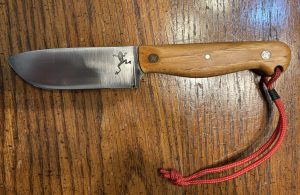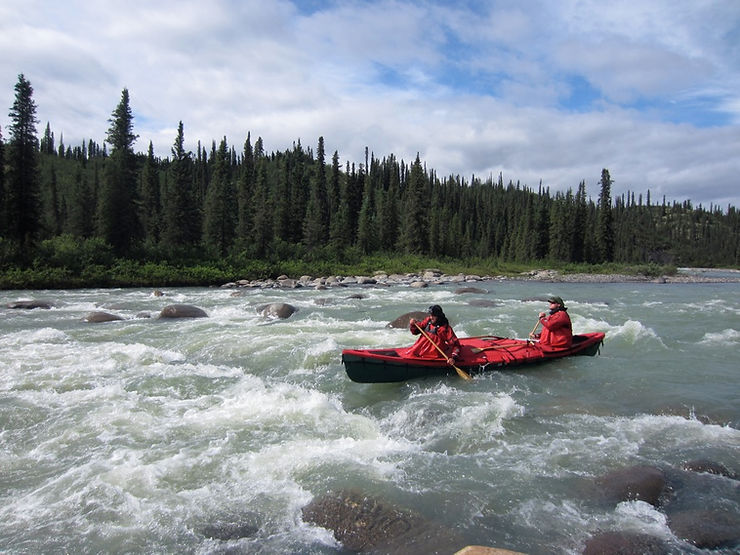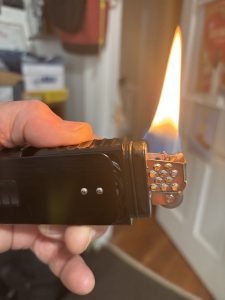
BIRTH OF A LEGEND: The Story of the Old Town Tripper Canoe!

Despite newer designs, the Tripper excels as well in tough rapids.
Some canoes are blistering fast but don’t turn worth a hoot. Others dog it on the flats but come alive in the maelstrom of winding rapids. Still others compromise speed and maneuverability for “all around” performance. Few canoes master this middle ground. The legendary Old Town Tripper is one of them.
There’s hardly a river anywhere that has not felt the smooth vinyl skin of an Old Town “Tripper.” Trippers have served as fishing boats on local ponds, as day cruisers for family floats, and as tripping canoes for summer camps. Liveries rent them because they are so strong; whitewater schools like the slalom-like ease with which they negotiate big rapids; and wilderness travelers revere the predictable way they handle rough water with heavy loads of camping gear aboard.
The Old Town Tripper is not a pure-bred whitewater canoe, though it can pass for one. Nor is it a competent lake cruiser, though it will serve admirably. It performs predictably on all types of water, and it doesn’t feel boggy no matter how much gear you stow aboard.
A meat and potatoes boat, this. And with a flair for whitewater, wild places, and the stuff of which canoe dreams are made. Love it or hate it, the Old Town Tripper has probably contributed more to modern canoesport than any other single canoe. The “Tripper” is one of a handful of canoes that–despite the demise of Royalex–remains in demand.* Designed nearly 50 years ago, by Old Town’s famed Lew Gilman, the Tripper (now made from polyethelene not Royalex) remains popular. It is an American classic whose heritage is as proud as apple pie.

Yellowknife, NWT. That well beat up canoe is “Old Blue.”
She’s headed for the Hood River.
It was Dean Gray, former owner of Old Town Canoe Company, who thought up the Tripper idea. He and Lew Gilman were observing whitewater canoe races around New England in the days when bulky Chestnut Prospectors were the most popular big water racing canoes. Why not design a competitive whitewater boat? Suggested Dean. Lew liked the 20 foot E.M. White and would have preferred to duplicate the big freighter, but deep down he knew a shorter canoe would be more popular, so he went right to work on a 17-footer.
The prototype was a high volume “banana” boat that would turn like crazy but wouldn’t track on the flats. So Gilman took the rockered slalom shape and added a re-curved, vee-shaped bow and stern to improve directional control. He told Dean that the recurved bows would do nothing for performance except give the canoe a classic Rushton look. Dean said “If it looks good, put it on.”
Lew built a fiberglass prototype and called the Old Town staff in for a look. The corporate opinion was unanimous: the boat was “slab-sided and too big.” And, it was nearly as ugly as the Chestnut (which in Lew’s words “…was ugly enough”)! Nope, it was out-of-style with the boats of the day: it would never sell. But Lew stuck to his guns and dryly affirmed that it would make “one hell of a white water canoe!” Then, with boat in tow, he proudly marched home to seek a second opinion. One look, and his daughter Laurie exclaimed: “Gee dad, it looks like a big tub!”
This was all the reinforcement Lew needed to polish his dream. He built a Royalex Tripper for Walter Abbott, a whitewater paddler who taught canoeing at the University of Maine. Walt put the new canoe through its paces, came back beaming, and told Lew it was the best whitewater canoe he’d ever used.
“That was the start of the Tripper,” said Lew. “It just sold like a son-of-a-gun!
Shortly after the Tripper hit the market–and tore the top off the sales chart–Dean Gray came and complimented Lew Gilman and told him that for the first time in many years, the company was running in the black.
If there’s a yankee definition of jack-of-all-trades, it’s Lew Gilman. Chemical, mechanical, or impossible; Lew will do it!
“My dad was quite a guy,” says Lew. He was very patient with everything, including me. He was the kind of guy who would start to fix a door and if he needed a hinge he’d say, “Well, I’ll be going downtown in a day or two; I can get it then.” If I were fixing the door, I’d be running downtown for that hinge!
There was a welding and repair shop down the road from Academy Hill, where Lew grew up. He went there every night, from the time he was 13, till he graduated from high school.
“They taught me a lot of the old trade secrets in metallurgy. I learned how to temper steel by eye and other things you just can’t learn from a book.”
Lew worked at the shop summers while he was in high school, and by the time he graduated, he had welded bridges and bulldozers. Then he went to work for the Air National Guard as a machinist, welder, and airframe repairman. “I could actually check the temperature of the annealing ovens by the color of the metal,” said Lew.
His infatuation with the Air Guard ended abruptly after a conversation with a gruff Lt. Colonel. The outfit needed a sandblaster that would fit inside the maintenance shop, so Lew built one.
“Where’d you get that?” Said the Colonel, pointing to the hulking machine.
“I built it.”
“How come?”
“I couldn’t get one that would fit in this room.”
“Jesus, that’s a good job. What the hell is a guy like you doing working for the government? If I could do that I wouldn’t be working for the damn government!”
With that, Lew put aside his government career and along with a friend, started a company called “Engineered Fiberglass,” which built toboggans. Neither man knew much about plastics, and that, combined with distribution problems, put the company under. Out-of-work, Lew started a foreign car repair service, though he knew nothing about the machines.
“I’d have people come in with Jaguars, Alfa Romeos, all kinds of expensive cars and ask if I could balance the wheels or fix the transmission or something else. And I’d say yep. ‘Ever worked on one before?’ They’d ask. Nope. But if somebody else was smart enough to make it, I sure as hell ought to be smart enough to fix it!
I lined up the front end of a Ferrari for a guy once, and I’ll tell you, the way he was about that car, I would rather have operated on his wife!”

Abuse is common on far northern canoe trips.
“Dragging” over tundra, ice, whatever is par for the course.
Lew could have prospered in the auto repair business, but deep down, he wanted to build canoes. So in 1962, he and Paul Rivers started the first successful fiberglass canoe company in New England. Soon, they turned their attention to a spanking new canoe building material called “Royalex” and began buying custom spec hulls from Uniroyal, which they trimmed out in their own shop. Ultimately, professional differences between the partners created a rift: when the company split in 1968, Gilman went to work for Old Town.
“I remember telling the guy from Uniroyal that within five years we’d (Old Town) be selling a million dollars worth of Royalex a year. He laughed. Well, we did, and they were amazed!”
IF AT FIRST YOU DON’T SUCCEED…
Lew Gilman: “Half the time someone’s calling you crazy or telling you you can’t do this or that. Then afterwards they say, ‘Oh yeah, I knew you could do it.'”
For example, When Lew began work at Old Town, he had an idea that canoes could be thermo-formed faster and easier than the way Uniroyal was doing it. The industry procedure was to frame the Royalex sheet with heavy iron to keep it rigid. Then, heat was applied and the softened Royalex was forced into the right-side-up mold.
The method was time-consuming and costly, and “…a lot of dirt and dust would get in there,” says Lew. “Matter of fact, the day I was there (at Uniroyal), a guy lost his cigarette lighter, and they molded a canoe around it!”
Gilman’s idea was to use an upside-down mold and unsupported (no frame) Royalex sheet. The mold would come down and vacuum the Royalex into shape. This would eliminate the bulky frame and a lot of labor.
When Lew asked the engineers why they couldn’t heat the sheet on the shelf without framing it, they simply said “it couldn’t be done,” which was just the incentive he needed to perfect the process for Old Town.
Says Lew: “I immediately built a little jury-rigged oven with shelves and took a small piece of Royalex and tried it. Sure enough, it worked all right.”
To keep costs down, Lew built the first machine out of scrap. The frame was made from railroad track and the mold was suspended with hand-operated chain pulls. He used the chain binders they have on logging trucks to hold the mold tight, and vacuumed it with an industrial vacuum cleaner!
A NEW “DISCOVERY”
Gilman was not always happy with the quality of Royalex which was supplied by Uniroyal, the nation’s only manufacturer of the material. So he devised a way of outfoxing the monopoly by rotationally molding polyethylene into what he called, “high density polyethylene sandwich”–aka the “Discovery” canoe.
Lew explains that cross-linking is achieved by linking the molecules together with a peroxide additive; i.e., the plastic first melts, then cross-links. Strangely enough, it goes from a semi-liquid back to a semi-solid, even though it gets hotter in the process. After that, it won’t melt again, which means you can’t repair it by conventional methods.
“I did it almost by mistake,” said Lew, as he unveiled the mystery of mending the plastic. “I had another type of material that I was trying to adhere and I sent it to Hexel in California, and they came up with a very effective adhesive. So I said geez, maybe that would do polyethylene. Well, it didn’t. But I knew that if you oxidize the surface of it very quickly, almost any adhesive will stick fairly well. So I just took a propane torch to it and it took a hell of a hold. Now, this method is considered a very effective way to fix both cross-linked and any other kind of polyethylene.”
Then, there’s the time that Lew shared his genius with the plastics industry.
Says Lew: “The accepted method for building molds for thermal-forming was to use a high temperature epoxy. But they were hard to handle and had to be post-cured after each use. I found that all the heat-resistant epoxies had a lot of aluminum in them so they would take the heat. So I devised a way to use polyester by loading it with aluminum powder and thinning it with a solvent.”
About a year after Lew started thermal forming, he talked to a guy from a company that made epoxies.
“What kind of epoxy are you using for your molds?” he asked.
“I’m not using epoxy.”
“Well, what are you using?”
“Polyester.”
“But you can’t do that!”
Lew told him he was 5,000 canoes too late with his advice!
Incredible, isn’t it? Small town boy learns to weld and temper metal in a local machine shop, then builds a $300 sandblaster for the federal government and artfully repairs expensive foreign cars he’s never seen. Later, he starts two profitable businesses and gives them up to design and build canoes for Old Town Canoe Company, granddaddy of them all. He single-handedly defies existing technology with his stubborn yankee belief that the impossible is both practical and profitable. That’s Lew Gilman–inventor, canoe designer, jack-of-all-trades, and real life American hero who pursued his dream and woke up smiling.
*When Royalex went out-of-production in 2013, Old Town began building the boats out of cross-linked polyethelene (aka, “Discoveries”). The 16’9″ OT “Discovery” is actually a “Tripper”: the slightly shorter length (16’9″ in poly vs.17’2″ in Royalex)) results from shrinkage in the mold). Paddlers won’t tell the difference.
Lew Gilman: 1929-2011.
———————————
*My flagship book, CANOEING WILD RIVERS, 5th Edition, contains a wealth of advice on how to safely canoe difficult rivers.
*My teen book, JUSTIN CODY’S RACE TO SURVIVAL! mixes a fictional wilderness survival tale with practical outdoor tips everyone should know–a first for books of this type. Adults love it too! Now available as an audio book!
*My book CAMPING’S TOP SECRETS, 5th Edition, details practical camping tips and procedures that only the experts know. If you know just a few of these tricks you’ll be a hero to your friends!
My book, BOUNDARY WATERS CANOE CAMPING, 3rd Edition, details everything you need to know to safely and enjoyably canoe the BWCA.
My 90-minute video, THE FORGOTTEN SKILLS details the most important camping skills. If you can do them all you’ll be a hero to your friends!

